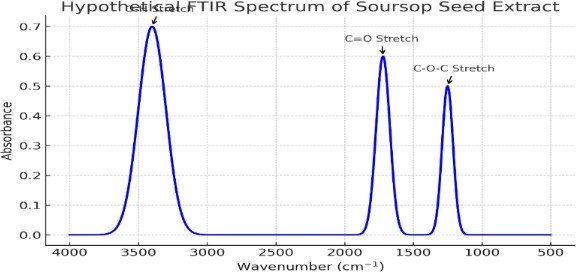Character of soursop seed (Annona muricata) as antimicrobial agent for packaging
Keywords:
Soursop Seed, Bioplastic, Aedes Aegypti, Phytochemical Composition, Biodegradability, Antimicrobial ActivityAbstract
This study investigated the phytochemical composition of soursop (Annona muricata) seeds and assessed their potential as a bioplastic material. Phytochemical screening confirmed the presence of alkaloids, flavonoids, tannins, phenolics, and saponins, which contribute to polymer formation and antimicrobial properties. Fourier Transform Infrared Spectroscopy (FTIR) analysis identified functional groups essential for biopolymer synthesis. A bioplastic film was developed using soursop seed extracts and tested for mechanical strength, biodegradability, and antimicrobial activity. The material exhibited moderate tensile strength and flexibility, demonstrating suitability for packaging applications. Biodegradability testing showed significant weight reduction over time, indicating environmental sustainability.
Antimicrobial analysis revealed inhibition of Escherichia coli and Staphylococcus aureus, suggesting potential use in food preservation. Comparative analysis with conventional bioplastics confirmed the viability of soursop seed-based bioplastic as an eco-friendly alternative. The findings highlight the potential of agricultural by-products in biopolymer production, contributing to waste valorization and sustainable packaging solutions.
Downloads
References
[1] T. Abdel-Rahman, A.-S. Hussein, S. Beshir, A. R. Hamed, E. Ali, and S. S. El-Tanany, 'Antimicrobial Activity of Terpenoids Extracted from Annona muricata Seeds and its Endophytic Aspergillus niger Strain SH3 Either Singly or in Combination', Open Access Maced. J. Med. Sci., vol. 7, no. 19, pp. 3127-3131, Oct. 2019. doi.org/10.3889/oamjms.2019.793
[2] C. J. da Silva Pens, T. V. Klug, L. Stoll, F. Izidoro, S. H. Flores, and A. de Oliveira Rios, 'Poly (lactic acid) and its improved properties by some modifications for food packaging applications: A review', Food Packag. Shelf Life, vol. 41, no. 101230, p. 101230, Jan. 2024. doi.org/10.1016/j.fpsl.2023.101230
[3] G. Aguilar-Hernández et al., 'Antibacterial activity of crude extract and purified acetogenins from Annona muricata seeds', Appl. Sci. (Basel), vol. 13, no. 1, p. 558, Dec. 2022. doi.org/10.3390/app13010558
[4] K. Ecevit, A. A. Barros, J. M. Silva, and R. L. Reis, 'Preventing microbial infections with natural phenolic compounds', Future Pharmacology, vol. 2, no. 4, pp. 460-498, Nov. 2022. doi.org/10.3390/futurepharmacol2040030
[5] R. Hartati, F. M. Rompis, H. Pramastya, and I. Fidrianny, 'Optimization of antioxidant activity of soursop (Annona muricata L.) leaf extract using response surface methodology', Biomed. Rep., vol. 21, no. 5, p. 166, Nov. 2024. doi.org/10.3892/br.2024.1854
[6] R. M. da Silva, I. de M. M. da Silva, M. M. Estevinho, and L. M. Estevinho, 'Anti-bacterial activity of Annona muricata Linnaeus extracts: a systematic review', Food Sci. Technol., vol. 42, 2022. doi.org/10.1590/fst.13021
[7] Y. Nolasco-González et al., 'Annona muricata leaves as a source of bioactive compounds: Extraction and quantification using ultrasound', Horticulturae, vol. 8, no. 7, p. 560, Jun. 2022. doi.org/10.3390/horticulturae8070560
[8] H. H. Orak, I. S. Bahrisefit, and T. Sabudak, 'Antioxidant activity of extracts of soursop (Annona muricata L.) leaves, fruit pulps, peels, and seeds', Pol. J. Food Nutr. Sci., vol. 69, no. 4, pp. 359-366, Nov. 2019. doi.org/10.31883/pjfns/112654
[9] Rady, M., et al. (2018). "Mineral composition, phytochemical and proximate studies of soursop." Ghana Journal of Science.https://www.ajol.info/index.php/gjs/article/download/251621/237771
[10] L. Santos, A. M. da C. Rodrigues, E. R. Amante, and L. H. M. da Silva, 'Soursop (Annona muricata) Properties and Perspectives for Integral Valorization', Foods, vol. 12, no. 7, p. 1448, Mar. 2023. doi.org/10.3390/foods12071448
[11] G. H. F. Viera, J. A. Mourão, A. M. Angelo, R. A. Costa, and R. H. S. dos F. Vieira, 'Antibacterial effect (in vitro) of Moringa oleifera and Annona muricata against Gram positive and Gram negative bacteria', Rev. Inst. Med. Trop. Sao Paulo, vol. 52, no. 3, pp. 129-132, May 2010. doi.org/10.1590/S0036-46652010000300003

Published
How to Cite
Issue
Section
Copyright (c) 2025 Authors

This work is licensed under a Creative Commons Attribution 4.0 International License.








